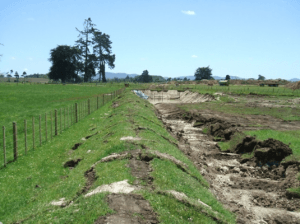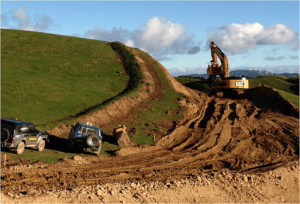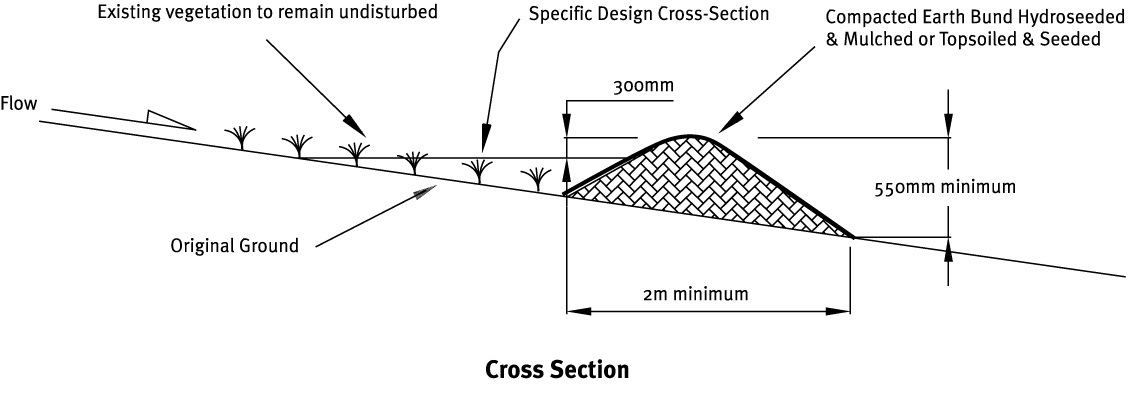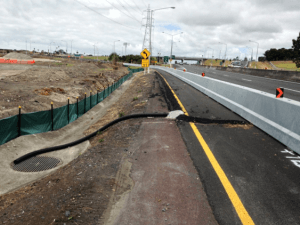Erosion Control
Water management controlsManaging ‘clean water’
What, Why, When, and issues to look out for
What

Turfing scraped from within the site to stabilise the perimeter bund. The perimeter bund provides both clean and dirty water control (Source: SouthernSkies).
Water that is ‘clean’ has usually come from above a work site and not run through the works area, so is not carrying sediment. Clean water is managed by creating a diversion, which is a non-erodible channel and/or bund that conveys clean water runoff. Diversions are constructed for a specific ‘design storm’, which means the storm of annual return probability – for example, 5% annual exceedance probability (AEP) storm.
Runoff diversions are channels that are usually constructed across a slope. This design means that a bund is usually needed on the downslope side to prevent flow from spilling out of the channel. A bund is earth that is formed into an embankment to hold back water. Hotmix diversion bunds are constructed of hotmix directly on the impervious surface and often replace a removed kerb and channel.
Runoff diversions may be:
- Drains, usually lined with an erosion-resistant material such as spray-on copolymer or needle-punched fabric
- Existing or new stormwater reticulation systems
- A combination bank or bund with excavated upslope channel
- An earthen bank, which is often made from compacted and stabilised topsoil
- Hotmix – which needs to be placed on a compacted and stabilised surface, not soil.
Why

Clean water diversion used to isolate upper clean water flows from the works area (Source: SouthernSkies).
These measures are mainly used to intercept and convey runoff to stable outlets, ideally at non-erosive speeds.
Clean water diversions intercept clean water away from the works area. They minimise the potential for erosion damage by reducing the volume of water flowing over the site. By reducing this volume of water they also minimise the potential for sediment generation and the size of sediment control device needed.
Hotmix diversion bunds can be used to divert runoff from impervious surfaces, which are typically motorway, roads, car parks or building platforms.
When
Clean water runoff diversion channels and bunds are mainly used in the following situations:
- To divert clean runoff water from above the works site, and divert it to non-erodible outlet(s)
- As a physical ‘perimeter boundary’ of an earthworks site, to isolate the site and stop clean water from entering the area.
Issues to look out for
Clean water diversions have the following limitations:
- The longitudinal gradients need to be less than 2%. If they are more than 2%, you will probably /need a channel lining. They should be stabilised and not at risk of eroding.
- All upslope (clean water) diversions need a stable outlet.
- You need to size and construct them for the site conditions. Don’t confuse them with contour drains.
- In some examples (eg steep slopes and/or unstable ground), specific geotechnical design will be required to make sure that the diversion works.
- Subsoils that are erodible and/or prone to piping failures may be exposed along the invert of excavated diversions. If left unchecked, serious lower slope stability problems may result, so make sure that the subsoils are stabilised properly before you put the diversions into use.
- On steep slopes it is often difficult to construct a channel bank or drain with the required channel capacity. You also need to consider where the clean water discharge point is located.
- Access for maintenance can be difficult once construction has started.
‘Clean water’ diversion: Design essentials
Whichever type of runoff diversion you are using, the following are design essentials for the tool to work.
When choosing the location
- Determine the location of any diversion measures by considering the contributing catchment area, outlet conditions, topography, land use, soil type, length of slope, seep planes (if seepage is an issue) and the development layout
- Where practical, choose a route for structures that avoids trees, existing or proposed service infrastructure, existing or proposed fence lines, and other natural or built features.
When designing upslope clean water diversions
- Diversions where catchments are bigger than 5 hectares (ha) need a formal design
- A standard clean water diversion arrangement may be used on sites smaller than 5 hectares (see cross-section of clean water diversion)
- Diversions must have sufficient capacity to safely carry the flow from a 5% annual exceedance probability (AEP) storm, plus a freeboard of 300 millimetres (mm)
- If the site is in the 1% AEP floodplain, consider how any flood waters may be managed, and any upstream and downstream consequences
- Include all calculations, design notes, drawings, etc in the site’s ESC Plan
- All clean water diversions need to be stabilised with no exposed surfaces
- If design velocities are over 1 metre per second (m/sec), you will need a channel liner to prevent scour
- Line any exposed temporary diversions with a spray-on copolymer channel liner or needle-punched geotextile fabric
- Outlets from all up-slope diversions must discharge water so that the erosion hazard to downslope lands and waterways is no greater than before the development started, up to the design storm event
- Include appropriate energy dissipation structures at the outlet of all diversions.
When designing the cross-section
- The diversion channels should be parabolic or trapezoidal in shape
- Make sure that the internal sides of the bund associated with the diversions are no steeper than 3:1, and the external sides are no steeper than 2:1, as shown:
When designing hotmix bunds
- Hotmix bunds are generally used to divert motorway and road runoff from immediately adjacent work areas.
- They are usually low, between just 150–300 mm high, and shaped to allow crossing by vehicles and avoid flooding of the motorway or road.
- Hotmix bunds direct runoff to a stabilised outlet, usually an existing or new stormwater inlet, catchpit manhole or similar. If there is no inlet like this, the bunds often discharge into small (150 mm) flexible pipes which convey the flows through the work area to suitable inlet devices. The capacity of these outlets is limited, which may require frequent spacing. Hotmix bunds are not appropriate for large catchments.
‘Clean water’ diversion: Construction and operation
When constructing and operating diversion channels and bunds

Turfing scraped from within the site to stabilise the perimeter bund. The perimeter bund provides both clean and dirty water control (Source: SouthernSkies).
- Plan and construct all perimeter diversion works as part of the initial site establishment and development.
- Prioritise these works and install the most important upslope control first.
- Define the route and survey it to achieve the correct gradient.
- Construct drains with a uniform grade along the invert, because sudden decreases may cause sediment to accumulate and the bank to overtop.
- Make sure that the bunds associated with the diversions are well compacted and stabilised. In some cases, this may require specific geotechnical design to ensure the stability and integrity of the structure.
- Stabilise all diversion areas. One method is to carefully set aside and replace existing grass and topsoil sods in the invert of the newly constructed drain, or over the newly constructed bund.
- Monitor diversions for erosion. Depending on the type of soils on site, erosion control will probably be needed where the gradients are greater than 2% or where the design velocities exceed 1 m/sec.
- Ensure the finished cross-section meets all design requirements.
- Provide an adequate outlet for each diversion. The outlet may be a stable channel (eg rip-rap, geotextile), vegetated or paved area, stable watercourse or pipe outlet. In all cases, the outlet must convey runoff to a point where outflow will not cause damage (erosion, flooding). Vegetated outlets should be installed before diversion construction, to make sure that the vegetative cover is established in the outlet channel.
‘Clean water’: Maintenance and decommissioning
Perimeter diversions require regular maintenance to ensure they keep functioning throughout their life.
When maintaining clean water diversions:
- Unless otherwise specified, inspect the diversions weekly, after every rainfall and during periods of prolonged rainfall, for scour and areas where the diversions may breach. Repair immediately if necessary to ensure that the design capacity is maintained
- Remove any accumulated sediment deposited in the diversion channel where there is a risk of overtopping due to a lack of freeboard
- Check invert and outlets to make sure that these remain free from scour and erosion. These points may require a spray-on copolymer or geotextile lining to avoid this effect
- Look for low spots, areas of water ponding, formation of tunnel gullies, sediment deposition and debris blockage
- Check for stabilisation cover and do remedial work as needed
- Take particular care to protect against damage from earthmoving operations. Reinstate the diversion if damaged.
When decommissioning clean water diversions:
- Remove diversions only when all disturbed areas below the clean water diversion have been stabilised
- Fill, compact and shape all disturbed areas to blend in with the finished landform
- Stabilise all the areas that were disturbed as part of the removal process. Apply seed and fertiliser, and protect with mulch or erosion-control blankets if required

